android and Flutter Developer
20+ android and Flutter Developer Interview Questions and Answers
Asked in ShivaLogic

Q. What is the difference between a Stateful and a Stateless Widget in Flutter?
Stateful widgets maintain state across rebuilds, while stateless widgets do not and are immutable.
StatefulWidget: Can change its state during its lifecycle. Example: Checkbox, TextField.
StatelessWidget: Immutable and does not hold state. Example: Text, Icon.
Stateful widgets require a createState() method to manage state.
Stateless widgets are simpler and faster to build since they don't manage state.

Asked in Krazio Cloud

Q. What is your preferred strategy for permanently addressing the ANRS issue?
To address the ANRS issue, a comprehensive strategy involving collaboration, education, and technology is essential.
Implement community outreach programs to raise awareness about ANRS.
Utilize mobile health applications to provide real-time data and support.
Collaborate with local health organizations to ensure resource availability.
Conduct regular training sessions for healthcare providers on ANRS management.
Leverage social media campaigns to educate the public on prevention a...read more
android and Flutter Developer Interview Questions and Answers for Freshers

Asked in Krazio Cloud

Q. How would you design a large-scale modular Android application?
Designing a modular Android app involves clear architecture, component separation, and efficient communication between modules.
Use a clean architecture approach, separating presentation, domain, and data layers.
Implement feature modules to encapsulate specific functionalities, e.g., a user profile module.
Utilize dependency injection frameworks like Dagger or Hilt for managing dependencies between modules.
Adopt a microservices architecture for backend integration, allowing ind...read more

Asked in Big Rattle Technologies

Q. How do you do state management in Flutter?
State management in Flutter is done using various approaches like setState, InheritedWidget, Provider, BLoC, Redux, etc.
setState is the simplest approach for small apps with few widgets.
InheritedWidget is used for sharing data across the widget tree.
Provider is a popular state management solution that uses InheritedWidget internally.
BLoC (Business Logic Component) separates business logic from UI and uses Streams to manage state.
Redux is a predictable state container that use...read more

Asked in Big Rattle Technologies

Q. Write code for swapping two numbers using only two variables.
Code for swapping two numbers using two variables only
Use a temporary variable to store the value of one variable
Assign the value of the second variable to the first variable
Assign the value of the temporary variable to the second variable

Asked in ACKO

Q. What is Bloc and what are its uses?
Bloc is a state management library for Flutter that helps manage the flow of data and events.
Bloc stands for Business Logic Component.
It helps separate the presentation layer from the business logic.
Bloc is commonly used with Flutter to handle state management and data flow.
It uses streams to handle asynchronous data and events.
Bloc pattern consists of events, states, and a bloc class to handle the business logic.
android and Flutter Developer Jobs




Asked in ITIO Innovex Pvt Ltd

Q. What is the difference between stateful and stateless widgets?
Stateful widgets maintain state across rebuilds, while stateless widgets do not and rely solely on their constructor parameters.
Stateful Widget: Holds state that can change during the widget's lifetime, e.g., a form input that updates as the user types.
Stateless Widget: Does not hold any state; it is immutable and only depends on the parameters passed to it, e.g., a static text label.
Rebuilds: Stateful widgets can rebuild when their state changes, while stateless widgets rebu...read more

Asked in TCS

Q. What is polymorphism?
Polymorphism is the ability of an object to take on many forms.
Polymorphism allows objects of different classes to be treated as if they are of the same class.
It is achieved through method overriding and method overloading.
Example: A parent class Animal can have child classes like Dog, Cat, and Cow. All these child classes can have their own implementation of the method 'makeSound', which is overridden from the parent class.
Polymorphism helps in achieving code reusability and...read more
Share interview questions and help millions of jobseekers 🌟


Asked in KONZE ENTERPRISES

Q. What is a Java interface?
Java interface is a blueprint of a class that has only abstract methods and constants.
An interface is declared using the interface keyword
It cannot be instantiated directly
It can be implemented by a class using the implements keyword
All methods in an interface are public and abstract by default
Interfaces can also have static and default methods
Example: public interface Drawable { void draw(); }

Asked in Big Rattle Technologies

Q. Write code for input swapping in Flutter.
Code for input swapping in Flutter
Create two TextEditingControllers to hold the values of the input fields
Use a temporary variable to swap the values of the controllers
Update the state of the input fields with the new values
Asked in ShivaLogic

Q. What is a stream builder?
A StreamBuilder is a Flutter widget that builds itself based on the latest snapshot of interaction with a Stream.
It listens to a Stream and rebuilds its child widget whenever new data is emitted.
Useful for displaying real-time data, such as chat messages or live updates.
Example: StreamBuilder<String>( stream: myStream, builder: (context, snapshot) { if (snapshot.connectionState == ConnectionState.waiting) { return CircularProgressIndicator(); } return Text(snapshot.data); }, ...read more
Asked in TechSheel

Q. what is dart and pattern?
Dart is a programming language used for building mobile, web, and desktop applications. Pattern refers to a reusable solution to a common problem.
Dart is an object-oriented language developed by Google.
It is used to build applications for Android, iOS, web, and desktop platforms.
Dart is known for its fast performance and easy-to-learn syntax.
Design patterns are reusable solutions to common software design problems.
They provide a structured approach to solving problems and imp...read more
Asked in TechSheel

Q. what is flutter and state?
Flutter is a UI toolkit for building natively compiled applications for mobile, web, and desktop from a single codebase. State refers to the data that can change over time in an application.
Flutter is a framework developed by Google for building cross-platform applications.
It uses a single codebase to create apps for Android, iOS, web, and desktop.
State in Flutter represents the data that can change over time in an application.
Flutter provides various ways to manage and updat...read more

Asked in ACKO

Q. What are the different types of state management techniques?
State management is a crucial aspect of app development to handle and update the state of the application.
Local State Management: Managing state within a widget using setState() method.
InheritedWidget: Sharing state across the widget tree using InheritedWidget.
Provider: A popular state management solution that uses InheritedWidget under the hood.
Redux: A predictable state container for managing the state of the app.
Bloc: A state management solution that uses streams and sinks...read more

Asked in ACKO

Q. What is a stateless widget?
Stateless refers to a widget in Flutter that does not have any mutable state.
Stateless widgets are immutable and their properties cannot change once they are initialized.
They are used for UI components that do not need to update or change based on user interactions.
Examples include static text labels, icons, and buttons that do not change appearance.
Stateless widgets are more efficient than stateful widgets as they do not need to manage state changes.
Asked in FlyCT Softtech

Q. Explain State Management Techniques.
State management techniques are used to manage the state of an application in a predictable and efficient manner.
Stateful widgets in Flutter can manage their own state internally.
Provider package in Flutter allows for a simple and efficient way to manage state.
Redux is a popular state management library for managing state in Android applications.
Asked in TechEsperto

Q. What is a StatefulWidget?
StatefulWidget is a class in Flutter that can hold state and can be rebuilt multiple times.
StatefulWidget is used when the UI needs to dynamically change based on user interactions or data changes.
It consists of two classes - StatefulWidget and State.
StatefulWidget is immutable, while State is mutable and holds the widget's state.
setState() method is used to notify Flutter that the widget's state has changed and needs to be rebuilt.
Example: TextField widget in Flutter is a St...read more

Asked in TCS

Q. What is your expected CTC?
My expected CTC is based on my experience, skills, and the industry standards.
My expected CTC is in line with the current market rates for Android and Flutter developers.
I have taken into consideration my years of experience and expertise in the field.
I am open to negotiation based on the overall compensation package offered by the company.
Asked in Avua International

Q. What is tween animation?
Tween animation creates smooth transitions between two states by interpolating values over time.
Tween animation involves defining a start and end state for an animation.
It uses interpolation to calculate intermediate values, creating smooth motion.
In Flutter, the 'Tween' class can be used to define animations, such as changing opacity or position.
Example: A 'Tween<double>' can animate a widget's size from 0 to 100 over a duration.
Tween animations can be combined with 'Animati...read more

Asked in Big Rattle Technologies

Q. Explain Flutter in detail.
Flutter is a mobile app SDK for building high-performance, high-fidelity, apps for iOS and Android, from a single codebase.
Flutter is developed by Google and uses Dart programming language.
It allows for hot reload, which means developers can see the changes they make in real-time.
Flutter has its own set of customizable widgets and also supports Material Design and Cupertino widgets.
It has a reactive programming model and supports asynchronous programming.
Flutter is used by po...read more

Asked in Infosys

Q. What is Flutter?
Flutter is an open-source UI software development kit created by Google for building natively compiled applications for mobile, web, and desktop from a single codebase.
Flutter is used to develop cross-platform applications.
It uses the Dart programming language.
Flutter provides a rich set of pre-designed widgets for building user interfaces.
It allows hot-reloading, enabling developers to see the changes instantly.
Flutter apps can be built for Android, iOS, web, and desktop pla...read more

Asked in ITIO Innovex Pvt Ltd

Q. What is Flutter?
Flutter is an open-source UI toolkit by Google for building natively compiled applications for mobile, web, and desktop from a single codebase.
Cross-Platform Development: Flutter allows developers to write code once and deploy it on multiple platforms, such as iOS, Android, and web.
Rich Widgets: Flutter provides a wide range of customizable widgets that adhere to specific design languages, like Material Design and Cupertino.
Hot Reload: This feature enables developers to see c...read more

Asked in Snapwork Technology

Q. Explain the lifecycle of a stateful widget.
Stateful widgets in Flutter have a lifecycle that includes various methods being called at different stages.
Stateful widgets have methods like initState(), didChangeDependencies(), build(), and dispose() that are called at different points in the widget's lifecycle.
initState() is called when the widget is inserted into the tree, didChangeDependencies() is called when the widget's dependencies change, build() is called to build the widget's UI, and dispose() is called when the...read more

Asked in Reliance Digital

Q. What are OOP principles?
OOPs (Object-Oriented Programming) is a programming paradigm based on objects and classes to structure software design.
Encapsulation: Bundling data and methods that operate on the data within one unit (e.g., a class).
Inheritance: Mechanism where a new class derives properties and behavior from an existing class (e.g., a Dog class inheriting from an Animal class).
Polymorphism: Ability to present the same interface for different underlying data types (e.g., method overriding in...read more
Asked in FlyCT Softtech

Q. What are the differences between Provider and GetX?
Provider and GetX are state management solutions for Flutter. Provider is more flexible and requires more boilerplate code, while GetX is simpler and more concise.
Provider requires more boilerplate code compared to GetX
GetX is simpler and more concise than Provider
Provider is more flexible and allows for more customization
GetX provides built-in functionalities like state management, dependency injection, and routing
GetX is known for its performance and ease of use

Asked in iTedium

Q. Explain the Flutter lifecycle.
Flutter lifecycle consists of various states that a widget goes through during its existence, impacting its behavior and performance.
Widgets can be in different states: 'created', 'mounted', 'updated', and 'disposed'.
The 'initState()' method is called when the widget is first created, ideal for initializing data.
The 'build()' method is called whenever the widget needs to be rendered, responding to state changes.
The 'dispose()' method is called when the widget is removed from ...read more
Interview Questions of Similar Designations
Interview Experiences of Popular Companies








Reviews
Interviews
Salaries
Users
















